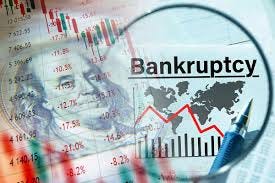Corporate Bankruptcies Spike and Household Debt Data is Flawed
Our Analysis on Q1 2025, and spike in corporate bankruptcies and household debt
Note: This newsletter contains information for educational purposes only, and the content below should not be considered financial advice to readers. We published a brand new short recommendation for our clients. If you would like to become our client, email laks@unicusresearch.com
Since January 2025, we have observed a drastic increase in corporate bankruptcies. Since May 2025, student loan defaults have been reported to consumer credit agencies, resulting in a drop of more than 200 points in consumer credit scores. You can read our articles on our Substack.
In this article, we will focus on the:
Bulging household debt and spike in corporate bankruptcies, with a particular emphasis on May 2025.
We will also focus on the economic warnings that CEO and CFOs of publicly traded companies give to their shareholders. Most importantly, a list of companies that are passing the tariff costs to the consumers. The companies also cited consumer affordability as a persistent issue affecting their sales.
Consumer Debt and Access to Credit - Our Analysis
The Federal Reserve Bank of New York's Household Debt and Credit Report for the first quarter of 2025 provides a detailed snapshot of U.S. household debt and credit conditions, offering insights into borrowing trends, delinquency rates, and financial health. This analysis summarizes the key findings, examines their implications, and provides a broader economic context based on the data from the Household Debt and Credit Report. We consider the household debt data not comprehensive due to the lack of BNPL data in the consumer credit.
Aggregate Household Debt: Total household debt reached $18.20 trillion in Q1 2025, a $167 billion increase from Q4 2024. This growth continues a long-term trend, with debt levels rising by $4.06 trillion since 2019. The steady increase suggests that households are relying on borrowing to finance major purchases, such as homes, or to manage living expenses amid economic pressures, including inflation. We expect that companies like WMT 0.00%↑ and TGT 0.00%↑ to pass on the tariff costs to their consumers, which would further pressure the already bulging consumer debt. We expect the data to catch up in the Q2 household and credit report.
Mortgage Debt Mortgage balances saw the largest increase, rising by $199 billion to $12.80 trillion. This growth reflects robust activity in the housing market, potentially driven by low interest rates, strong demand, or rising home prices. Home Equity Lines of Credit (HELOC) balances also increased by $6 billion to $402 billion, $85 billion above their Q1 2022 low. This suggests homeowners are leveraging home equity for various purposes, such as renovations or debt consolidation. To learn more about the nuances of mortgages, subscribe to
.Credit Card and Auto Loan Debt Credit card balances decreased by $29 billion to $1.18 trillion, a notable quarterly decline, though they remain 6.01% higher than Q1 2024. Similarly, auto loan balances fell by $13 billion to $1.64 trillion, marking the second consecutive quarterly decline since Q2 2011. These reductions may indicate cautious consumer behavior, possibly in response to economic uncertainty or efforts to reduce high-interest debt. However, we are concerned



